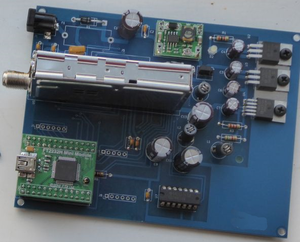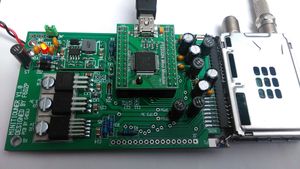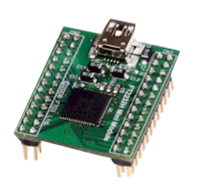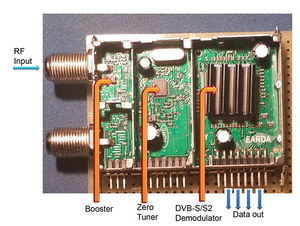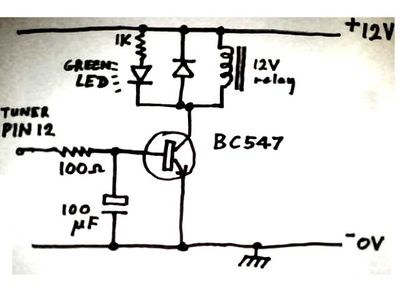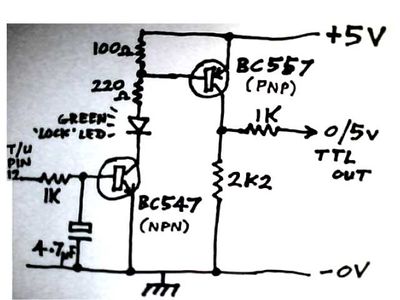Minitiouner Hardware
The MiniTiouner, developed and designed by Jean-Pierre F6DZP, is a DVB-S/S2 USB receiver card and measurement tool that works with the software "Minitioune".
Original schematics are here : http://www.vivadatv.org/viewtopic.php?f=80&t=366
Overview
The MiniTiouner hardware consists of 3 main parts:
PCB and Power supply
The main PCB contains the power supply for the 5, 3.3 and 1 volt rails and there are 2 variants of the MiniTiouner main PCB - as of April 2017 new builders should only refer to the version 2 build documentation.
Version 2
As from April 2017 only the version 2 PCB designed by Mike G0MJW is available - only the wide coverage Serit Tuner can be used with this board.
See this page for more details, part list and construction tips.
Version 1
Version 1 was the original PCB designed by Brian G4EWJ and sold in the BATC shop until early 2017 - this board is no longer availaable and new builders should read the version 2 build documentation.
See this MiniTiouner hardware Version 1 wiki page for details.
USB module
The MiniTioune receive hardware is connected to a Windows PC running the MinITiouner software over a standard USB 2.0 port.
The pre-programmed USB module available from the BATC shop acts as a 2 channel USB converter between the PC USB port and the NIM. One channel is used for control and monitoring and the other carries the Transport stream data from the NIM.
The NIM
The NIM or Network interface module is the little metal box found inside Satellite Receivers (also called the tuner) and typically contains 2 chips : the Zero Tuner and the Demodulator. RF Signal is sent to the antenna connector "RF input", it is amplified by a transistor "booster", the zero tuner selects the frequency asked and the demodulator extracts the data (Transport Stream) that goes outside the NIM on a digital parallel output.
The BATC shop used to sell a Sharp and Eardetek NIM with frequency coverage from 650 MHz through to 2600 MHz and so need an upconverter to receive 146 and 437 MHz. As of February 2017 the Sharp and Samsung tuners are no longer available and the project now uses a NIM tuner from Serit (model FTS4335) which covers from 143.75 MHz right through to 2450 MHz without the need for any upconverters.
This extended frequency coverage gives greater flexibility and means up converters from the VHF and UHF bands are not required and enables the 10 GHz band, including Es'HailSat-2 down link, to be received on a standard domestic PLL LNB. This makes building a receiver for 146 or 437 much easier, although you will need a pre-amp followed by lots of filtering for each band, just like the Sharp did, and probably followed by a Satellite line amp from ebay as the Serit has less gain than the Sharp.
However, due to a different pinouts from the Sharp NIM, the Serit FTS4335 NIM tuner will also need a simple adapter board to enable it to be plugged in to the MiniTiouner standard hardware - Brian G4EWJ has designed a board and these are available from the BATC shop. The adapter board and the Serit FTS4335 NIM tuner are available from the BATC shop.
Full details of this board and using the tuner are available here.
Note: As of April 2017 a new main PCB is being designed to directly take the Serit tuner - any new constructors should wait for the new board which will not need the adapter PCB. You only require the adaptor PCB if you are upgrading existing MiniTiouner hardware to include the Serit tuner. Check this page to work out if you should upgrade.
Compatible NIM types
Only NIMs ( Network Interface Module) or tuners that have the following STMicroelectronics chips can be used:
- Zero tuner chip can be STB6100, STV6110, STV6111, STV6120
- Demodulator chip STV0903, STV0913, STV0910
The following NIMs can be used:
- Eardatek EDS-4B47FF1B+ (sold by BATC shop during 2015 / 16)
- Sharp F7VZ0169 (sold by BATC shop during 2016)
- Samsung DNBU10711IST
- Samsung DNBU10512IST
- LG TDQX-S001F
- Serit SP2246
- Serit FTS-4335 (Sold by BATC shop in 2017)
Note - the NIM Serit FTS-4335 has a different pins configuration (40pins, not 26 pins) , so an adapter for "old pcbs" has been designed by Brian G4EWJ
So what do I need to buy?
The Minitiouner hardware is designed for home construction:
- The USB interface is available ready programmed from the BATC shop.
- The main PCB can be bought from the BATC shop. Note we are currently (April 2017) redesigning the board for one that will take the Serit tuner directly.
- Serit adapator PCB? See note above
- The tuner or NIM. The Serit unit covering 143 - 2450 MHz is available from the BATC shop
- SUP2400 70cms upconverter - The BATC shop sells this unit which is used to upconvert 146 and 70cms to L band. You do not need to buy it if you are using the Serit tuner.
All other components are available from normal suppliers.
Full details on how the build the MiniTiouner including a "how to video" and a zip file containing circuit diagram, layout and build instructions can be found on the MiniTiouner hardware wiki page. Please note the “full kit” mentioned in documentation is no longer available.
Fitting a lock detector
When Minitiouner is used at repeater site a lock detector is required to tell the repeater logic when a signal is being received. Several designs based around the NE567 have been used but the simplest and most reliable is from Robin, G8DRK.
The 22kHz from the tuner is coming from a 3.3V port which is normally zero volts. When it outputs the 22kHz tone it does it by pulsing up to +3.3 volts with a 50% duty cycle. So we can simply smooth that and get about 1.6 volts - more than enough to turn a transistor on.
This circuit should drive most small 12 volt "signal" relays. If relay needs more than 90mA consider using a smaller one or try a beefier transistor but with a gain of at least 100.
This following circuit provides a 5-volt TTL output when the 22 kHz tone is present:
In both circuits the green LED functions as a Lock-LED, as long as you set "22kHz_switch=2" in the MiniTioune.ini file.
